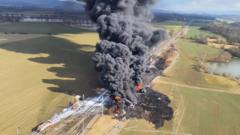Communities are increasingly relying on advanced technology to detect methane, a potent greenhouse gas linked to health risks, particularly asthma among children. Volunteers in Washington DC have been using handheld monitors to uncover methane leaks in homes and neighborhoods, revealing alarming concentrations that exceed safety levels. Simultaneously, innovative satellite systems like the recently launched Tanager-1 aim to identify large-scale methane emissions more accurately, providing essential data to pinpoint pollution sources. As these technologies advance, the importance of addressing methane emissions becomes clearer, prompting calls for faster action and stronger regulatory frameworks.
### Detecting Methane: Challenges and Imperative Solutions

### Detecting Methane: Challenges and Imperative Solutions
Efforts to monitor methane emissions highlight technology's essential role in tackling environmental health issues.
In and around Washington DC, local volunteers have been assessing air quality utilizing sophisticated handheld gas monitors that resemble walkie-talkies but are equipped with advanced sensors designed to detect various gases, including methane. Over a continuous 25-hour period of monitoring, these researchers uncovered 13 significant outdoor methane leaks, registered at concentrations above the lower explosive limit, and identified several leaks occurring within residential units. Health implications are considerable, as methane and pollutants like nitrogen oxide—often emitted from gas stoves—are closely linked to heightened asthma rates. "It’s very heartbreaking and alarming when you realize some people are trapped in these hazardous conditions," recalls Djamila Bah, a healthcare worker who leads community initiatives through Action in Montgomery.
Although methane is harmful to human health, it is also a powerful greenhouse gas, with a short atmospheric lifespan yet far greater capabilities for heat retention compared to carbon dioxide (CO2). Methane's diverse emission sources include fossil fuel production, waste management, and agricultural practices. However, detecting methane isn't straightforward. Handheld devices and infrared cameras make detection feasible, but different monitoring methods—such as vehicle or drone-mounted sensors—integrate to enhance data accuracy and coverage. Andreea Calcan from the International Methane Emissions Observatory explains that while no method is perfect, the growing availability of affordable sensors can facilitate extensive monitoring to address both minor leaks and significant emissions.
On a more extensive scale, satellites increasingly provide critical insights into methane emissions, with the newly launched Tanager-1 satellite capturing large-scale leaks like those from oil fields. This satellite, developed by Carbon Mapper in collaboration with NASA and Planet Labs, aims to deliver high-resolution imagery and prompt identification of emissions, akin to switching from a telephoto to a wide-angle camera for clearer views. Despite inherent challenges—such as detecting emissions in snowy, vegetative landscapes or under cloud cover—the Tanager-1 aims to refine gas leak identification across diverse environments. Emission data from Tanager-1 is being released to inform industry stakeholders and regulators, marking a pivotal step towards managing methane emissions more effectively.
However, piecing together comprehensive methane emissions data presents hurdles. Tools like the Methane Alert and Response System (MARS) monitor emissions via satellite input, sending alerts to companies and authorities upon detecting methane plumes. Since its initiation, MARS has generated over 1,200 alerts for significant leaks, though only 1% resulted in actionable responses. Still, optimism abounds as collaborations enhance communication and responses to alerts improve, leading to successful emission reductions in some instances. "Our knowledge empowers us," remarked Joelle Novey from Interfaith Power and Light, reflecting the transformative potential of community engagement in environmental monitoring. As awareness grows, the importance of addressing methane emissions—and the technology harnessed to do so—remains a pressing global challenge.





















